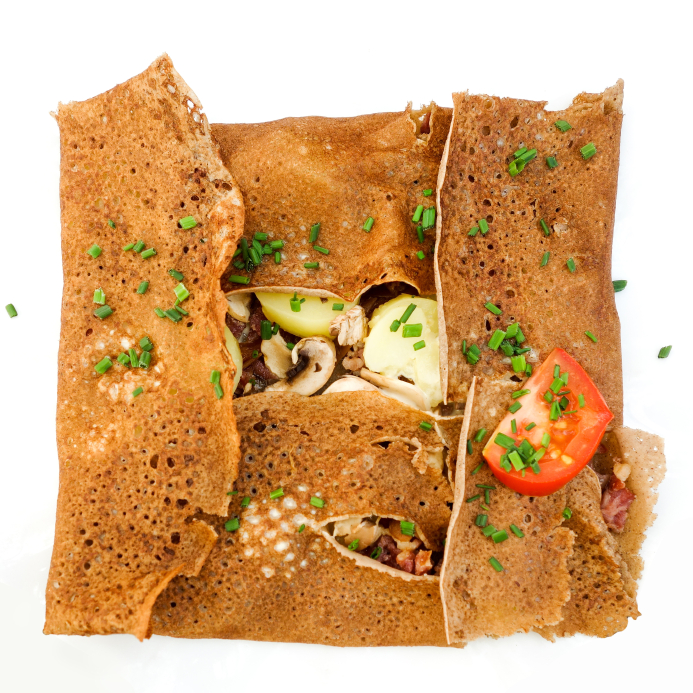
THE FRENCH
FOOD
INDUSTRY'S PORTAL
Webzine
taste it to info

Discover the cuisine of Brittany
Focus regions /
Friday 12 June 2015
Baudic considers local ingredients to be of the utmost importance. “I try to help local businesses, ” he says. “They need us to value their work, and it’s important to ensure they continue these traditions, so that we can preserve our local resources. ”
Savor the Savory: Buckwheat Crêpes
Crêpes are one of Brittany’s most successful exports; in the region, it’s savory buckwheat crêpes, known as galettes, that rule supreme. Traditional recipes call solely for buckwheat flour; naturally devoid of gluten, and therefore require a certain amount of technique to create thin, lacy crêpes to fold around a variety of fillings like eggs, ham and cheese.
This tradition dates back to the 12th century, when buckwheat was introduced into the region from the Middle East; the plants – and the recipe – have thrived on the moors of Brittany ever since.
Drink Up! Cider and Chouchen
Traditionally served with galettes is a bowl of local cider, a 2,000-year long Breton tradition. Two main types are produced today: dry (sec ) and sweet (doux ). Some of the very best Breton cider comes from Cornouaille, the first region to have its cider recognized by an AOC label. Also note that the Cornouaille cider is the only cider recognized by an AOC label in Brittany!
Chouchen is another alcoholic beverage produced in the region. Similar to mead, chouchen is made with honey, often buckwheat honey. Chouchen’s main distinction from other meads is in the addition of local apple juice, a tradition that hearkens back to Celtic recipes, which used both cider and honey to make the brew.
A slightly less traditional but no less delicious alcoholic beverage is Breton whiskey. Mr. Baudic’s favorite distillery, Celtic Whiskey Compagnie, makes “a high, high quality Breton whiskey. They do an internationally well-recognized job. ”
On the Sweeter Side of Things: Kouign-amann and Palets Bretons
Brittany has several pastries to be proud of, including kouign-amann (pronounced “queen aman”), a specialty of Douarnenez, where it originated in the mid-19th century. Its translation to butter cake is no exaggeration: kouign amann is made of layers of flaky, buttery pastry and caramelized sugar. Traditionally, as in much of Breton pastry, local salted butter is used.
Yet another buttery local specialty are Palets Bretons, which are biscuits composed of 20% salted butter. The name comes from the metal disks used to play jeu de palets, which the biscuits resemble in shape. This game has been played since the 14th century, though it wasn’t until 1923 that the Société des Paletistes was created in Rennes. The associated pastry is regaining in recognition as well and is has been undergoing approval for a geographic protection certificate since 2012.
Seafood: A Local Treasure
Brittany is one of the most celebrated seafood regions in France. According to Mr. Baudic, this resource is a major part of what distinguishes the region.
Mussels hailing from the bouchots in the Bay of Mont-Saint-Michel are fleshy and perfectly suited for preparations a la marinière, or with white wine and shallots (à la marinière ). Mr. Baudic prefers local Saint-Jacques scallops, “an extraordinary benefit of the region. ” Blue Atlantic Brittany lobster is full of flavor, but it’s Brittany’s oysters from Belon and Cancale that are lauded for their meatiness and celebrated throughout the country.
Seafood platters have become so popular in Brittany’s restaurants that restaurateurs signed a “Bretagne Qualité Mer” charter with the French government in 2010, to guarantee an authentic platter of fresh, local seafood every time you order.
Of course, these products just scratch the surface of what Brittany’s cuisine has to offer. Mr. Baudic has a few favorites, including kig ha farz, “a really typically Breton dish ,” made of meats stewed with a buckwheat flour pudding, and far Breton, a prune cake.
The region of Brittany is a major basin for French agriculture with other products such as artichokes, cauliflower (75% of all cauliflower produced in France is grown in Brittany), Plougastel AOC strawberries and Roscoff AOC onions.
Perhaps what best defines Brittany’s gastronomic culture is indeed its diversity. According to Mr. Baudic, “We have a diversity that other regions don’t have. They may be specialized in a product, but not in everything the way that we are. You’ll never find as much diversity and quality as you do in Brittany. ”





